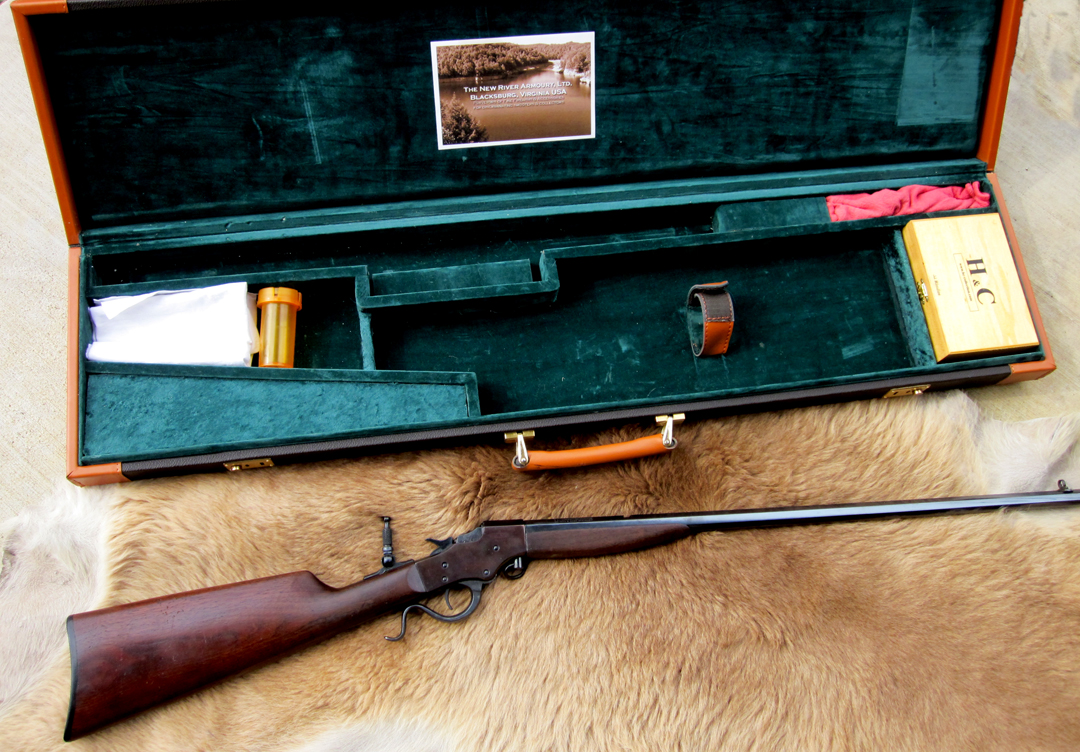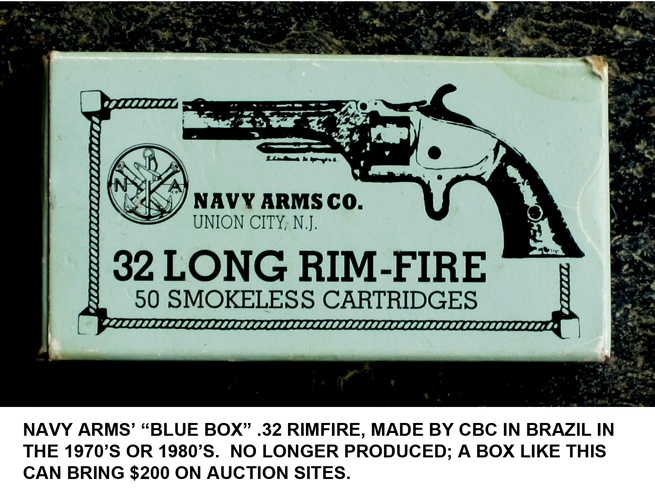

As readers of this blog know, some time ago I acquired the pretty little Stevens single-shot rifle shown above. It's chambered for the long-discontinued .32 Rimfire caliber. I have used this rifle on small game with great success. Not surprising, because the .32 Rimfire is one of the best small game calibers ever designed.
Unfortunately it's also one of several rimfire calibers that were “casualties” of the Second World War: ammunition makers tooled up to fill contracts with the government for vast quantities of small arms ammunition, and brass and lead were strategic materials that had to be allocated to other calibers. Additionally by 1942 the market for the larger rimfire calibers (.25 and .32) was going soft, largely due to improvements in the performance of .22 Long Rifle ammunition. The ammo makers therefore had several acceptable reasons to discontinue production of the .25 and .32 calibers and probably were glad to see them go away, because even after the war production was never resumed. Existing quantities fed the civilian market for a while but eventually dried up. The .32 Rimfire is no longer loaded by any American company.

Some years ago Navy Arms Company contracted with CBC in Brazil to make some of the older rimfire calibers, including the .32 Rimfire. CBC made a pretty fair amount but only for a short time; the stocks of this excellent ammo have been used up in the decades since the contract was signed, and prices for a box of it—when you can find it at all—have skyrocketed. I bought several boxes when I got my little Stevens at around $40 per box of 50; today I could easily sell a full box for four or five times that much. One alternative is available: a company in France makes a kit with re-usable cases to reload the .32 Rimfire, using black powder and “acorn” style blanks as primers. These work pretty well, but are a bit of a PITA to prepare and the kit isn’t cheap. Furthermore black powder (the only propellant you can safely use with the kit) is dirty stuff requiring immediate post-shooting cleanup. CBC’s ammunition was loaded with smokeless powder and had non-corrosive priming. It was great stuff, very accurate and excellent for small game.

Since nobody makes .32 Rimfire any more, of course nobody is making guns for it either. But there are thousands of high-quality rifles (and some handguns) chambered for it sitting in closets or safes or hanging on walls gathering dust. Some of them have been adapted to shoot .32 centerfire calibers,  but that’s unwise for many reasons. First, they’re still collector’s guns and altering them hurts their value. Second, inevitably some ignorant yahoo will load ammunition far too hot for the relatively weak actions of such old guns, destroying not only the rifle but possibly also the shooter. It would be far better to provide new ammunition and let the old guns “speak for themselves” in the field. And that is my point: there are no better small game rounds than the larger rimfire calibers, including most especially the .32 Rimfire.
but that’s unwise for many reasons. First, they’re still collector’s guns and altering them hurts their value. Second, inevitably some ignorant yahoo will load ammunition far too hot for the relatively weak actions of such old guns, destroying not only the rifle but possibly also the shooter. It would be far better to provide new ammunition and let the old guns “speak for themselves” in the field. And that is my point: there are no better small game rounds than the larger rimfire calibers, including most especially the .32 Rimfire.
Now, American shooters have long been conditioned by ammunition makers and gun writers to believe that muzzle velocity is the be-all and end-all of ammunition performance. The notion that“Faster is better, and don’t you ever forget it,” isn’t true: a heavy bullet at moderate velocity will do what needs to be done efficiently and effectively. This has been proven time and again with centerfire calibers used on big game, but it’s no less true when discussing small game ammunition.
The .32 Rimfire is certainly no speed demon: it fires a 90-grain lead round-nosed bullet at a leisurely 950-1000 feet per second (FPS) for a muzzle energy of 180 foot-pounds (FP). But a “high velocity” .22 Long Rifle fires a 40 grain bullet at 1355 FPS or a 37-grain hollow point at 1365 FPS: muzzle energies of these two bullets are 158 FP and 150 FP respectively. So that big .32 bullet—nearly two and a half times the weight of a standard .22 Long Rifle bullet—has nevertheless more energy than the .22 LR does despite its much lower velocity.
So why is the .32 so good as a small game round? A couple of reasons: first, the larger cross section of the .32 bullet, coupled with its mass, makes it a very, very effective killer on small game. The bullet keeps moving after impact—it has, in other words, considerable momentum—and in doing so it makes a permanent wound channel larger than the .22’s do, bigger even than the hollow-point bullet of the .22 Long Rifle. And it comes out the other side, which is not always the case with the smaller caliber. Make a hole that size through a squirrel or a rabbit and he isn’t going anywhere.
There is more: the .32 doesn’t mess the meat up. The old saying “You can eat right up to the hole,” applies. I’ve shot squirrels with the .32 and not only is there minimal tissue damage, there's virtually  no “bloodshot” meat. The .22 long Rifle, especially with hollow points, can damage a lot of meat, the main reason why squirrel hunters are advised to take only head shots. This is even more true of the .22 WMR or the various very-high velocity .17 caliber rounds. If you’re going to eat the animals you shoot, the less damage the better is the way I see it; and in this respect the .32 Rimfire is just about the perfect small game round.
no “bloodshot” meat. The .22 long Rifle, especially with hollow points, can damage a lot of meat, the main reason why squirrel hunters are advised to take only head shots. This is even more true of the .22 WMR or the various very-high velocity .17 caliber rounds. If you’re going to eat the animals you shoot, the less damage the better is the way I see it; and in this respect the .32 Rimfire is just about the perfect small game round.
In fairness it must be said that the low-speed .32 Rimfire isn’t a flat-shooting caliber, which limits its range to 50-75 yards. But that’s not much of a handicap. How many people shoot rabbits or squirrels beyond 50 yards, or even as far away as 50 yards? Not many.
So here is my proposition: I would like the readers of this blog to contact the ammunition makers and ask them to bring the .32 Rimfire back onto the market, even if only in one or two batches per year. From time to time I’ve run into Val Forgett III (who runs Navy Arms) and broached the subject; but I've always been told that, “Plans are in the works.” Nevertheless, so far…no dice, and no .32 Rimfire. If everyone who thinks that this fine old round should get a new lease on life would please contact the ammo companies, and most especially
Navy Arms LLC, 54 Dupont Road, Martinsburg WV 25404
(302) 274-0004
Send Navy Arms an e-mail using the link above, and let’s hope some savvy marketing executive will take notice. A real demand exists for cartridges to be used in the guns that served our fathers and grandfathers well.
Let’s do it! Resurrect the .32 Rimfire!
| HUNTING | GUNS | DOGS |
| FISHING & BOATING | TRIP REPORTS | MISCELLANEOUS ESSAYS |
| CONTRIBUTIONS FROM OTHER WRITERS|
| RECIPES |POLITICS |